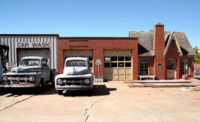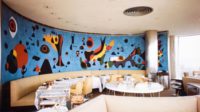The Glass House and National Trust for Historic Preservation Announce the Restoration of Philip Johnson’s 1949 Brick House

Philip Johnson's Brick House at the Glass House campus in New Canaan, Connecticut. Photo courtesy The Glass House
The yin to the yang of Philip Johnson’s Glass House, the Brick House—also known as the Guest House—is a critical element of the late architect’s 49-acre estate in New Canaan, Connecticut (a work in progress between 1949 and 1995), which opened to the public as a historic house museum in 2007. Clad in iron-spot brick in a Flemish bond pattern, the 900-square-foot Brick House presents a solid foil to its glazed counterpart, mirroring its 56-foot length across a grassy court and containing the mechanical equipment that supports each, with the pipes and wiring below the ground between them. The Brick House is only half as deep, however, providing cozy quarters for such notable overnight visitors as Andy Warhol and Phyllis Lambert, and—over time—Johnson and his partner David Whitney, who eventually used it as a private retreat until their deaths in 2005.

Designed as guest quarters, the Brick House was built adjacent to its famous glazed neighbor. Photo courtesy The Glass House
Originally, the Brick House, completed in 1949 just months before the Glass House, was divided into three equal-sized rooms, each with an oversized, porthole window on its eastern face—the only elevation with fenestration, though skylights were cut into the west side of the building’s flat roof to balance daylight. In 1953, the architect combined two of the rooms into one large bedroom with an adjoining bath and reading room. At one time opulent and luxurious, with walls lined in Fortuny cotton, this primary suite featured sleek white vaults inspired by the breakfast room at Sir John Soane’s house museum in London. The Clouds of Magellan, a 1953 sculpture by Ibram Lassaw, hung prominently on the wall above the bed, while works collected by Johnson and Whitney were displayed in a corridor that connected to the reading room, home to Johnson’s personal library of philosophy, history, art history and fiction books.
Closed to the public since 2008 due to an increasing state of disrepair, the Brick House is finally getting the care and attention it deserves through $1.8 million secured by the National Trust for Historic Preservation. Built at the base of a slope, the structure has always been susceptible to water infiltration. This was compounded by more recent failures of the flat roof and skylights, which caused such interior damage as deterioration of the plaster, mold growth, and rusting mechanical systems.

1

2
Archival interior photos of the Brick House, including views of its main corridor (1) and of the bedroom with its Clouds of Magellan sculpture by Ibram Lassaw (2). Photos courtesy The Glass House
Beginning in 2022, preservation architect Mark Stoner, who serves as the National Trust’s Graham Gund Architect, utilized extensive conservation studies and surveys completed by Li ⋅ Saltzman Architects in 2010 to develop plans for a thorough building and site rehabilitation. He is joined by a skilled project team that includes engineering firms Landtech (civil), Altieri Sebor Wieber (m/e/p), and RSE Associates (structural). Hobbs, general contractor, is executing the work, which began in September of this year, and includes improvements to the site drainage, the cleaning and restoration of the masonry, metal, portal windows and front door, a new roof and skylights, and a full upgrade of building systems serving both the Brick and Glass Houses. Renovation of the interior is set to launch in January, beginning with the walls and plaster.

3

4

5

6
Work that kicked off in September included removal of the living room "moon" windows (1); aerial view of roof repair progress (2); existing condition of hallway (3) including detail of extensive water damage (6). Photos by Michael Biondo, courtesy The Glass House

Archival photo of the Brick House. Photo courtesy The Glass House
All artwork, furniture, and books, removed in 2010, have been preserved and stored safely at an off-site location. They will be reinstalled when construction is complete. In addition, Fortuny, the source for the bedroom’s existing wallcovering, is donating the production of the same fabric to replace the water-damaged original, and Edward Fields Carpet Makers—the company that worked with Johnson on the bedroom floorcovering in 1953—is providing replacement carpets.
“We are incredibly excited to finally be able to introduce visitors to such an integral part of the Glass House story,” says Kirsten Reoch, the new executive director of the National Trust-owned and -operated Glass House. “Launching this major restoration, as we reach the 75th anniversary of its construction, is a testament to our commitment as stewards of this National Trust Historic Site and we look forward to using the Brick House as a catalyst for more projects ahead—both future restorations of our buildings, landscape and collections and as inspiration for new site-specific artistic commissions in the future.”




